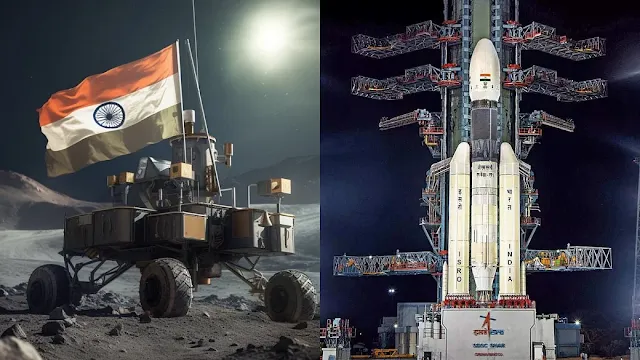India's Lunar Saga Continues with Chandrayaan-3
 |
India's Lunar Saga Continues with Chandrayaan-3 |
In
the vast expanse of the cosmos, the moon has always held a special
place in human curiosity and exploration. Over the years, numerous
missions have been launched to unlock the mysteries of Earth's celestial
neighbor. India, with its progressive strides in space technology, has
emerged as a notable player in lunar exploration. The Chandrayaan series
of missions, undertaken by the Indian Space Research Organisation
(ISRO), showcases the nation's commitment to advancing scientific
knowledge and technological prowess. In this blog, we delve into the
remarkable journey of Chandrayaan-3 and its historic successful landing
on the moon.
Chandrayaan-3: A Continuation of Success
Chandrayaan-3
is the third installment in India's ambitious lunar exploration
program. Building on the achievements of its predecessors, Chandrayaan-1
and Chandrayaan-2, this mission aimed to further unravel the moon's
mysteries and enhance our understanding of its geological and
mineralogical characteristics.
Mission Objectives
Chandrayaan-3
was designed with a primary objective of conducting a successful soft
landing on the moon's surface, an endeavor that had been attempted by
Chandrayaan-2 as well. The mission also sought to deploy advanced
instruments to analyze the moon's composition, study its exosphere, and
map its topography with unprecedented accuracy.
Technical Marvels: The Architecture of Chandrayaan-3
The
architecture of Chandrayaan-3 is a testament to India's engineering
excellence. The mission comprised two key components: the Orbiter and
the Lander-Rover duo. The Orbiter, equipped with state-of-the-art
scientific instruments, would remain in lunar orbit to conduct remote
sensing and data collection. Meanwhile, the Lander-Rover duo would carry
out the crucial task of landing on the moon's surface and conducting
in-situ studies.
The Journey to Success: Mission Phases
Launch and Trans-Lunar Injection: The journey of Chandrayaan-3 began
with a flawless launch atop a powerful GSLV Mk III rocket. After
achieving the necessary escape velocity, the spacecraft embarked on its
trajectory towards the moon, setting the stage for its eventual
rendezvous.
Lunar Orbit Insertion: Upon reaching the
moon's vicinity, Chandrayaan-3 executed a precise maneuver to enter
lunar orbit. This phase required intricate calculations and precise
execution to ensure that the spacecraft was captured by the moon's
gravity.
Descent and Soft Landing: The most
nail-biting phase of the mission was the descent and landing. The
Lander, equipped with cutting-edge landing technology, executed a series
of maneuvers to gradually decrease its velocity and ensure a gentle
landing on the lunar surface. This phase demanded split-second decisions
and real-time adjustments to ensure a successful outcome.
Rover Deployment and Surface Operations: Once
safely on the moon, the Lander released the Rover, which began its
exploration of the lunar surface. Equipped with sophisticated
instruments, the Rover conducted analyses of soil composition,
temperature variations, and other crucial parameters.
Orbiter Operations:
While the Lander and Rover focused on surface activities, the Orbiter
circled the moon, collecting high-resolution data through its advanced
sensors. This data was transmitted back to Earth and contributed
significantly to our understanding of the moon's geological evolution.
Triumphant Landing and Discoveries
The
culmination of Chandrayaan-3's journey came with its successful soft
landing on the moon's surface. The Lander-Rover duo touched down in a
carefully selected region that held great scientific potential. The
Rover's initial analyses provided insights into the moon's regolith
composition and surface characteristics. High-resolution images sent by
the Rover showcased the moon's rugged terrain, giving scientists and
enthusiasts alike a breathtaking view of our closest celestial
companion.
Scientific Impact and Future Endeavors
Chandrayaan-3's
achievements have left an indelible mark on lunar exploration. The data
collected by its instruments have significantly contributed to our
understanding of the moon's origin, evolution, and potential resource
utilization. The successful landing and operational capabilities of the
Rover also serve as a stepping stone for more ambitious missions,
including the possibility of human exploration.
In Conclusion
Chandrayaan-3
stands as a testament to India's prowess in space technology and
scientific exploration. The mission's successful landing on the moon's
surface, coupled with the invaluable data collected by its instruments,
has propelled our understanding of the moon to new heights. As we
celebrate this achievement, we also look forward to the future, where
more ambitious missions will continue to unravel the mysteries of the
cosmos and inspire generations to come.
